Birds
Media

Species Types
Scientific Name
Euphagus carolinus
Description
Missourians most often see rusty blackbirds during spring and fall migration, though in southern Missouri they sometimes stay through the winter. Look for them foraging in pastures and fields near water.
Media

Species Types
Scientific Name
Podiceps auritus
Description
Horned grebes are small ducklike birds that may be seen in Missouri during migration and locally in the winter. Breeding coloration is different from that of winter.
Media
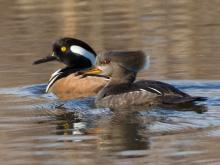
Species Types
Scientific Name
Lophodytes cucullatus
Description
Hooded mergansers have crests that trail behind the head or can be raised to create a circular shape. Their bills are narrow and serrated. Males are black and white with chestnut flanks; females are brown.
Media
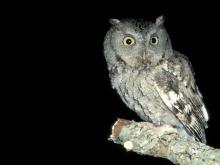
Species Types
Scientific Name
Otus asio
Description
This owl—which really doesn’t “screech”—can be gray, brown or red, but in Missouri you can verify your identification by noting its small size, yellow eyes and prominent ear tufts.
Media
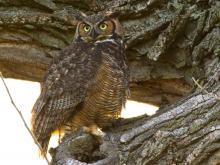
Species Types
Scientific Name
Bubo virginianus
Description
The great horned owl has wide-set ear tufts and a white throat. After dark, you can identify it by its three to eight deep hoots grouped in a pattern, such as “hoo h'HOO, HOO, HOO.”
Media

Species Types
Scientific Name
Asio otus
Description
The long-eared owl is strictly nocturnal and highly secretive by day. This crow-sized owl hunts over open country at night.
Media
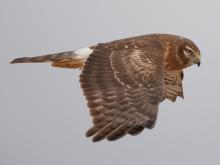
Species Types
Scientific Name
Circus hudsonius (sometimes called C. cyaneus)
Description
The northern harrier is a hawk of wetlands and grasslands. It has long wings and tail, a white rump patch, and an owl-like facial disk. Males are gray, females are brown. The flight pattern is distinctive.
Media
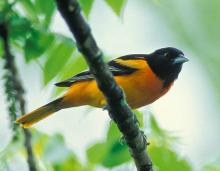
Species Types
Scientific Name
Icterus galbula
Description
Often, you'll hear the male Baltimore oriole's loud, flutelike song before you locate the bright orange singer as he moves among the boughs of trees.
Media
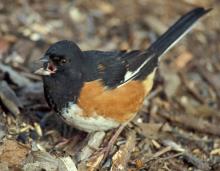
Species Types
Scientific Name
Pipilo erythrophthalmus
Description
Often heard before seen, the eastern towhee scratches vigorously on the ground in fallen leaves and sings its telltale “drink your teeeeee!” and “chewink!”
Media
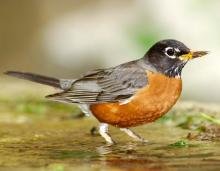
Species Types
Scientific Name
Turdus migratorius
Description
A well-known symbol of springtime, this bird hunts on the ground for earthworms and insects. The robin’s colorful rusty-red breast is as welcome in spring as its cheerful singing at dawn and dusk.
See Also







Media

Species Types
Scientific Name
Hemaris diffinis
Description
The snowberry clearwing is a moth that confuses people because it looks like a bumblebee and flies like a hummingbird!
Media

Species Types
Scientific Name
Hyles lineata
Description
The white-lined sphinx moth sometimes confuses people because it flies, hovers, and eats from flowers like a hummingbird. The adults often fly during daylight hours as well as in the night and are often found at lights.
Media

Species Types
Scientific Name
Darapsa myron
Description
The Virginia creeper sphinx moth is common in woods and brushy areas and comes to lights at night. The larvae eat Virginia creeper and grape leaves.
Media

Species Types
Scientific Name
Perimyotis subflavus (formerly Pipistrellus subflavus)
Description
Tri-colored bats, formerly called eastern pipistrelles, are relatively small and look pale yellowish or pale reddish brown. The main hairs are dark gray at the base, broadly banded with yellowish brown, and tipped with dark brown.
Media

Species Types
Scientific Name
Myotis grisescens
Description
Gray myotises are difficult to distinguish from other mouse-eared bats. A key identifying feature of the gray myotis is that its wing is attached to the ankle and not at the base of the toes. It’s an endangered species.
Media

Species Types
Scientific Name
Myotis lucifugus
Description
The little brown myotis (little brown bat) is one of our most common bats, but populations are declining. White-nose syndrome has taken a heavy toll in northeastern states. This species is now listed as vulnerable across its range.
Media

Species Types
Scientific Name
Myotis sodalis
Description
The Indiana myotis, or Indiana bat, summers along streams and rivers in north Missouri, raising its young under the bark of certain trees. It is an endangered species.
About Birds in Missouri
About 350 species of birds are likely to be seen in Missouri, though nearly 400 have been recorded within our borders. Most people know a bird when they see one — it has feathers, wings, and a bill. Birds are warm-blooded, and most species can fly. Many migrate hundreds or thousands of miles. Birds lay hard-shelled eggs (often in a nest), and the parents care for the young. Many communicate with songs and calls.





















